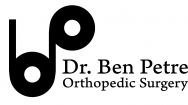Shoulder Dislocation
A shoulder dislocation is when the humeral head comes out of the glenoid completely. In other words, when the ball comes out of the socket. Dislocations are often a traumatic event and may even need a doctor, anesthesia, or even surgery to put them back in. The ball and socket joint of the shoulder is inherently unstable. The socket part of the ball is nearly flat and so the joint resembles a golf ball sitting on top of a golf tee. It requires many ligaments, muscles and the labrum for the ball (humeral head) to stay centered in the socket (glenoid of the scapula). The labrum is like a chalk that one would stick under your tire to keep your car from rolling. Without it, the ball can roll off of the golf tee. The two most common structures to be injured with a shoulder dislocation are the labrum (especially in younger patients) or the rotator cuff (especially in older patients). Many other structures are at risk, the bones can fracture, nerves and blood vessels can be damaged and the stabilizing ligaments of the shoulder can be torn. Treatment will depend upon your age, number of dislocations and associated injured structures. The younger you are, the more likely a dislocation is going to recur. Treatment varies from immediate range of motion exercises, activity modification, sling and physical therapy all the way to reconstructive surgery.
Non-Surgical Treatment
For patients with their first dislocation and no major tears or fractures, non-surgical treatment is often preferred. Non-surgical treatment is centered around balancing the healing of the ligaments and tendons in the shoulder while preventing shoulder stiffness. This is accomplished through the use of a shoulder immobilizer most of the day with a focused PT program to safely move the shoulder to prevent stiffness. Once the shoulder is healed, the PT program will advance to full motion and begin strengthening to allow return to work and sports. Dr. Petre will guide your therapy regimen to ensure you have a good result.
Surgical Treatment
Surgery is often the best treatment for a number of different scenarios including: shoulder dislocations that have happened more than once, a young and active patient, failed previous non-surgical or surgical treatment, or if there are major tears that will not heal without surgery. Most surgery is arthroscopic and is focused on repair the damaged structures to restore the normal anatomy of the shoulder. This includes repairing the labrum, the shoulder ligaments, the capsule or the rotator cuff. In certain circumstances such as if surgery has failed before, if you have broken the glenoid bone, or if the glenoid anatomy is such that a repair is likely to fail, a bone block procedure is recommended. This is an open surgery where a piece of bone is transferred from one location in the shoulder to another, creating a bony bumper to stop the shoulder from dislocating. Recovery from shoulder dislocation surgery takes a full 4 months before patients can return to sports or active jobs. Most can use their hands in front of them on a computer for example in a few days, but a shoulder sling is required for 6 weeks after surgery. Patients will be involved in physical therapy 2-3x/week for months after surgery and should plan to take time off of work or school to recover properly to obtain the best result.
